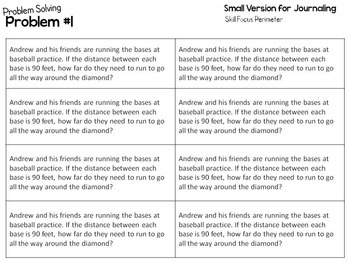Measurement Problem Solving for Interactive Notebooks or Math Journals
- Zip
Also included in
- Enhance your students' math problem-solving skills with our comprehensive Math Word Problem Solving Bundle, perfect for math journals! Designed specifically for 3rd and 4th-grade classrooms, this exciting digital resource is here to revolutionize how your students approach story problems. Say goodbyPrice $25.00Original Price $50.00Save $25.00
Description
Applying measurement concepts can be challenging for students. Your students need opportunities to practice and understand converting between units in the metric and customary measurement systems, area, perimeter, and volume. While measurement worksheets can be a great place to start the practice, this Problem of the Day problem solving journal is designed to promote critical thinking and multi-step problem solving around the essential customary and metric measurement skills and standards.
There are 20 measurement word problems in this pack. Each problem is provided in three formats to allow for personalized implementation. A full-page prompt is provided for display and discussion. This version includes a photograph to engage learners. This is available as a display in a slideshow as well.
A small and large version of each prompt are included. These are designed to be glued into interactive math notebooks.
There are also templates provided to help students break down problems using 4-step problem solving strategy designed to help students attack word problems more effectively.
Product Contents:
•20 measurement word problems in 3 sizes.
•3 problem solving templates - with 2 formats for each prompt
•Slideshow version of all prompts for digital display
•Teacher Guide for suggested use & lesson structure
•Answer keys
Get these measurement problem solving prompts for only $3 when you purchase them as part of the Math Problem Solving Journal Prompt BUNDLE.
Check out these other math products available:
Multiplication Problem Solving Journal Prompts
Addition and Subtraction Problem Solving Journal Prompts
Fractions Problem Solving Journal Prompts
*********************************************************************
Product download information:
This product download is a digital file that will extract a folder that contains the purchased file(s). If you need help opening or printing a file, please refer to tech help within TpT by clicking here OR by clicking here for corrected printing
Terms of Use:
© 2015 The Third Wheel. All rights reserved by author. These materials are intended for personal use by a single classroom only. Copying for more than one teacher, classroom, department, school, or school system is prohibited. For use in multiple classrooms, please purchase additional licenses. This product may not be distributed or displayed digitally for public view. Failure to comply is a copyright infringement and a violation of the Digital Millennium Copyright Act (DMCA). Clipart and elements found in this PDF are copyrighted and cannot be extracted and used outside of this file without permission or license. See product file for clip art and font credits.
Got questions?
Click here to contact Mrs. D at The Third Wheel






